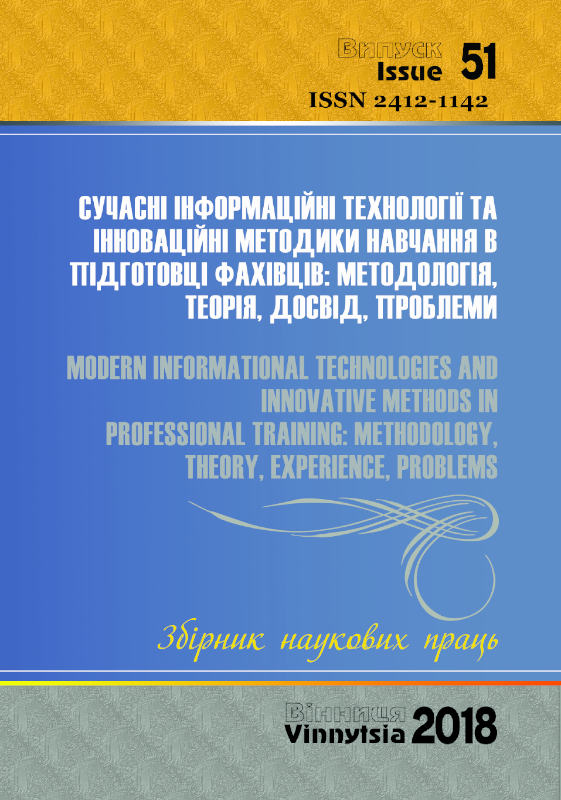BLENDED AND DISTANCE LEARNING OF FOREIGN LANGUAGE: GENESIS, PROSPECTS OF IMPLEMENTATION IN THE LEARNING PROCESS
Keywords:
blended learning, traditional education, distance learning, Moodle, e-learning, person-oriented approach, foreign languages, higher education, e-learning, information and communication technologies, genesis of the distant learningAbstract
The relevance of the material presented in the article is caused by the rapid development of
computer technologies and their use in the educational process. The article is devoted to the implementation of
modern technologies, namely, distance and mixed learning, into the process of studying foreign languages in higher education institutions. The scientific literature was analyzed, which allowed the author to reveal the main stages of the
origin of distance learning. The basic requirements for the foreign language teacher were highlighted, the role of which
remains invariably significant, even with the application of modern teaching technologies. The author emphasizes the
application of a person-oriented pedagogical approach in the use of blended learning, which makes this method very
effective, compared with traditional methods of teaching. The main advantages provided for students studying a
foreign language with the use of mixed learning are shown. An important aspect of using mixed learning is that the
student can determine his own learning path. The tasks placed on the Moodle platform differ in their variability, which allows students to reveal their abilities and talents, regardless of their classmates. The combination of traditional face-
to-face and distance learning methods, complemented by the latest technology, gave us an up-to-date and highly valued way of learning foreign languages - "blended learning". The prospects of its implementation in the learning
process are also shown.
Downloads
References
Змішане навчання [Текст]: монографія / С.М. Березенська, К.Л. Бугайчук, В.М. Кухаренко, Н.Ю. Олійник,
Т.О. Олійник, О.В. Рибалко, Н.Г. Сиротенко, А.Л. Столяревська; за ред.. В.М. Кухаренка – ХПІ, Харків,
– 275 с.
Воротникова, І.П. Змішані моделі навчання у післядипломній педагогічній освіті [Текст] / І.П.
Воротникова // Перспективні напрямки світової науки: Збірник статей учасників тридцять першої
міжнародної науково-практичної конференції «Інноваційний потенціал світової науки -XXI сторіччя» (25
лютого - 1 березня 2015 р.). – Том 1. Науки гуманітарного циклу. – С. 29-31.
Данькевич Л.Р. Ефективність застосування системи змішаного навчання у викладанні ділової
англійської мови [Текст] / Л.Р. Данькевич // Науковий вісник Національного університету біоресурсів і
природокористування України. – 2009. – Вип. 137. – С. 236-239.
Кухаренко В.М. Системний підхід до змішаного навчання [Текст] / В.М.Кухаренко // Інформаційні
технології в освіті. – 2015. – No 24. – С. 53-67.
Пьяных Е.Г., Немчанинова Ю.П. Смешанное обучение как эффективная форма работы с магистрами в
области естественно-научного образования[Текст] / Е.Г. Пьяных, Ю.П. Немчанинова // Вестник ТГПУ. –
– No7. – С. 257-260.
Рашевська Н.В. Змішане навчання як психолого-педагогічна проблема[Текст] / Н.В. Рашевська // Вісник
Черкаського університету. Серія «Педагогічні науки», Черкаси: ЧНУ. – 2010. – Вип. 191. – С. 89-96.
Фандей В.А. Смешанное обучение: современное состояние и классификация моделей смешанного
обучения [Текст] / В.А. Фандей // Информатизация образования и науки. – 2011. – No 4(12). – С. 115-125.
Шроль Т.С. Змішане навчання як нова форма організації ІКТ-освіти [Електронний ресурс] / Т.С. Шроль //
Оновлення змісту, форм та методів навчання і виховання в закладах освіти. – 2016. – Вип. 13(1). – С.
-170. – Режим доступу: http://nbuv.gov.ua/UJRN/Ozfm_2016_13(1)__52
Holmberg, Börje (2005). The evolution, principles and practices of distance education. Studien und Berichte
der Arbeitsstelle Fernstudienforschung der Carl von Ossietzky Universität Oldenburg [ASF] (in
German). Bibliotheks-und Informationssystem der Universitat Oldenburg. p. 13. ISBN 3-8142-0933-8.
Retrieved 23 January 2011
Tait, A. (1996). Conversation and Community: Student Support in Open and Distance Learning. In R Mills and
A Tait (Eds.) Supporting the Learner in Open and Distance Learning (p. 59-72). London: Pitman.
Distance learning ... a magazine for leaders. Volume 2, #6, ISBN 9787774554229.
Rothblatt, Sheldon; Muller, Detlef K.; Ringer, Fritz; Simon, Brian; Bryant, Margaret; Roach, John; Harte,
Negley; Smith, Barbara; Symonds, Richard (1988). "Supply and Demand: The "Two Histories" of English
Education". History of Education Quarterly. 28 (4): 627
Osguthorpe, Russell T.; Graham, Charles R. Quarterly Review of Distance Education, v4 n3 p. 227, Fall 2003
Allan Barbara: “Blended learning: Tools for Teaching and Training”, Facet Publishing, 2007, ISBN 978-
, 228 pages
Климов Е.А. Психология профессионального самоопределения. М.: Академия, 2004. 304 с.
Сидоренко Т.В. Принципы отбора и методической адаптации оригинальных видеоматериалов //
Вестник Воронежского государственного университета. Серия: Лингвистика и межкультурная
коммуникация. 2012. No 1. С. 207-210.
Downloads
Published
Issue
Section
License
Copyright (c) 2018 Ю. Шаранова

This work is licensed under a Creative Commons Attribution 4.0 International License.

